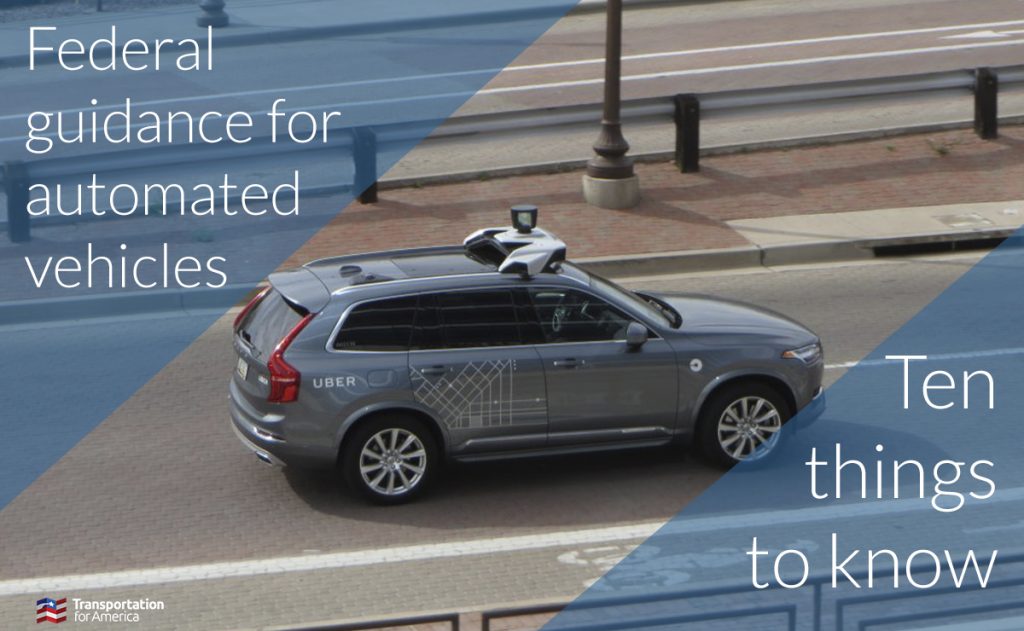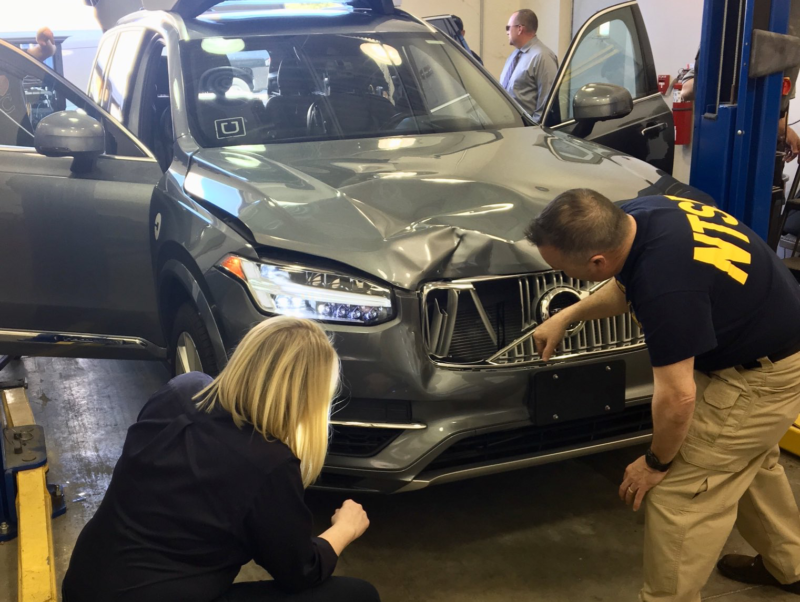Ten things to know about USDOT’s new framework to guide the future of automated vehicles
The USDOT’s newly released policy guidance for automated vehicles is consistent with Congress’ attempts to limit regulations and give private industry carte blanche to operate mostly in secret with little public oversight.

Recently, the U.S. Department of Transportation (USDOT) released Preparing for the Future of Transportation: Automated Vehicles 3.0, the Department’s latest effort to try and describe a plan for integrating automated vehicles. This updated version of 2017’s Automated Driving Systems 2.0: A Vision for Safety fails to answer basic questions, leaves local communities with few tools to safely integrate this technology onto their roads, and puts private industry in control of what data local communities can access about automated vehicles.
This policy guidance is voluntary, but it does start to provide a big-picture view of how USDOT is approaching this emerging industry at the same time that Congress is trying to pass their first comprehensive law to regulate it. Here are 10 key things you need to know about this guidance:
1) USDOT is doing nothing to help states and cities receive vital data on AV operations
Local governments recognize that in order to properly manage their roadways, ensure safety for all, and provide service to the residents who face the most transportation barriers (low-income people, communities of color, and people with disabilities), they need data on operations and travel patterns of automated vehicles. Yet this guidance is virtually silent on this critical issue, only restating the principles outlined in 2.0 for developing “voluntary data exchanges.”
This is simply unacceptable.
Without a robust federal framework to set expectations and requirements for sharing data, the likeliest outcome is that local communities will be pitted against each other in a race to the bottom to attract AV companies by enacting little to no regulation, thus ensuring the public will stay in the dark about AV deployment on their local roadways, leaving millions of Americans in harm’s way. Such was the case with Arizona’s move to create a highly permissive and opaque regulatory climate, where a pedestrian was struck and killed by an automated Uber earlier this year.
2) Public safety officials will be left in the dark
Tacked onto the very end of the guidance is a section in which USDOT encourages “engagement” with first responders and public safety officials. However, once again, the guidance does not provide any instruction or best practices for how manufacturers, communities, and public safety officials should engage with one another. Further, without access to data, public safety officials will have zero idea about how these vehicles are operating and will likely be unable to fully execute their responsibilities.
3) It ignores the impact on land use and curb space in cities
The guidance contains 120 words on two of the most pressing impacts of automated vehicles for cities: land use and curb space. Continuing with the theme, the guidance tells cities to consider the implications of automated vehicles on the built environment, but doesn’t provide cities any of the tools (like data) necessary to do so.
4) Automation will almost certainly increase congestion, but that’s just a problem for cities to figure out on their own
The guidance contains even fewer words—only 85!—on the congestion impacts of automated vehicles. USDOT correctly notes that automated vehicles can create an entirely new problem of zero occupancy vehicle trips and potentially drive riders away from transit, further increasing vehicle miles traveled and road congestion, but does little to even start a discussion about how to deploy AVs without increasing congestion. A study from the SFCTA released just a few weeks ago noted that the overwhelming majority of new congestion on San Francisco County’s streets are due to ridesourcing companies, the same companies most eager to deploy AVs on a wide scale. We are working hard through our Smart Cities Collaborative to help communities plan for integrating automated technology without increasing congestion, but communities need USDOT to provide more than a one-paragraph acknowledgement that there may be an issue.

NTSB investigators in Arizona examining the automated Volvo operated by Uber that killed a pedestrian. Photo by the NTSB.
5) Safety assessments are still voluntary—and not that helpful
Previous iterations of federal AV guidance encouraged manufacturers to provide “voluntary safety assessments” to help build “public trust, acceptance, and confidence through transparent testing and deployment of ADSs [automated driving systems].”
If you tell your kids that making their beds is voluntary, do you think most will still go to the trouble? Only a few of the companies that are testing have even met this low bar, and most are just glossy marketing docs with little to no substantive information. This new guidance encourages manufacturers to make these voluntary safety assessments public, but if a manufacturer fails to provide a useful assessment and make it easy for the public to find and understand, there are no repercussions. It’s also important to note that the template from NHTSA isn’t really asking for the kind of information that would be most helpful for the public.
6) USDOT will adapt definitions for “driver” and ”operator” to incorporate driverless vehicles, but crucially fails to define “performance.”
This action, while a potentially useful step that recognizes a changing world, does not address an even bigger question about terminology: how to interpret the word “performance”. Why is the definition of this single word important? The AV legislation currently being considered by Congress (The AV Start Act) would preempt most state and local laws and regulations that affect the “design, construction, or performance” of a highly automated vehicle or automated driving system.
“Performance” has traditionally referred to the mechanical operation of a vehicle or vehicle component. But now, given that the driver of AVs will be both mechanical and software-based in nature, the lack of a definition for “performance” in the AV START Act (or any other federal law for motor vehicles) will likely lead to lengthy and costly legal fights over the definition and whether or not proposed state and local laws or regulations will affect it.
While USDOT acknowledges that they want to “strike the appropriate balance between the federal government’s use of its authorities…and the State and local authorities’ use of their traditional powers,” the guidance provides no indication of how USDOT’s views on what the appropriate roles are for federal, state, and local governments. The lack of clarity is a significant concern for local communities who are left unsure if current control over their roads will, in the end, apply to this new technology.
7) USDOT says it already has the authority to set testing and regulatory standards for vehicles configured without human controls. What?
If true, this begs the question: why do we even need federal AV legislation? This guidance states that, for high-level and full automation, “NHTSA’s current safety standards constitute an unintended regulatory barrier to innovation” and that, “in an upcoming rulemaking, NHTSA plans to seek comment on proposed changes to particular safety standards to accommodate automated vehicle technologies and the possibility of setting exceptions to certain standards.” If USDOT feels that they (through NHTSA) already have this authority to set safety standards for AVs, why are the House and Senate even considering legislation? The guidance is completely silent on further explaining this critical topic for local communities and the public.
8) USDOT wants to update the federal manual that governs street design to “take into account” automated driving
As with anything, the devil is in the details. AV 3.0 provides no details on when or how the Manual on Uniform Traffic Control Devices (MUTCD) will be updated, only that the FHWA is conducting research. As previously stated, this guidance does nothing to provide communities with data about how automated vehicles are performing, so how would communities or even the FHWA have the foggiest idea what kinds of updates are required for the MUTCD to incorporate AVs in a productive and safe way?
9) The guidance advises state legislatures to adopt common terminology and assess roadway conditions
USDOT really leaves states holding the bag with this one. The guidance tells states to use voluntary, consensus-based terminology when discussing automated vehicles. While it provides an example, in practice, it allows 50 states to select 50 different ways of discussing this new technology. In the next paragraph, the guidance states that “states may want to assess roadway readiness for automated vehicles, as such assessments could help infrastructure for automated vehicles, while improving safety for drivers today.” How would states or cities have any idea how to “assess roadway readiness” considering that the guidance (as with the AV START Act,) completely and utterly fails to provide communities with any data about how and where automated vehicles are operating?
10) Complete Streets get a welcome shout out, but only in the “transit” section.
We were pleased to see that this guidance recognized the value of complete streets policies in improving safety. However, the guidance refers to these policies only in the context of transit, in encouraging transit providers to review complete streets policies when planning for automation. Complete streets are a proven tool to make streets and cities safer, with or without transit or automation, and the most potentially dangerous impacts of AVs will be felt by those who are not driving and attempting to share the road with them while walking and biking, as well as taking transit.



















